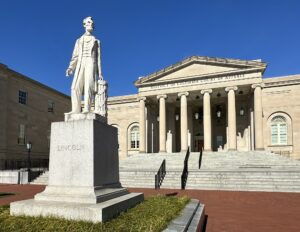Amid the Trump administration’s cancellation of billions in federal funding for climate action, the Sabin Center has covered the numerous cases that have been brought in federal district courts to challenge federal grant cancellations. Among those cases is Climate United Fund v. Citibank, a challenge to the Environmental Protection Agency’s (EPA) unlawful termination of $20 billion in federal funding awarded through the Greenhouse Gas Reduction Fund (GGRF). The D.C. Circuit Court of Appeals recently ruled that the Court of Federal Claims (CFC) is the proper forum for the lawsuit—a flawed decision that has potentially significant consequences for the future of GGRF grantees and their projects to provide financing and technical assistance for various greenhouse gas reduction activities.
By way of background, many plaintiffs with terminated grants are bringing their cases in district courts, raising constitutional, Administrative Procedure Act (APA), and/or other statutory claims and seeking injunctive relief. The federal government has argued that those lawsuits are actually contractual claims that belong in the CFC. In August 2025, the Supreme Court issued an emergency order in American Public Health Association v. National Institutes of Health, in which the Court suggested that the correct forum for challenges to grant terminations was the CFC. Shortly thereafter, the D.C. Circuit Court of Appeals issued a decision to set aside the preliminary injunction in Climate United Fund v. Citibank, holding (1) the district court lacks jurisdiction over the APA and regulatory claims, which are actually contract claims that belong in the CFC; and (2) the plaintiffs are not likely to succeed on the merits of their constitutional claim. The Sabin Center’s recent blog posts provide more detail on the Supreme Court’s order and the D.C. Circuit’s decision.
This forum debate is significant in federal funding litigation because the CFC is limited in the remedies that it can award, and plaintiffs may only secure partial relief in the CFC. But, before the Supreme Court and lower federal courts began re-routing these high-profile grant termination cases, the CFC flew under the radar. This blog post provides a primer on the CFC, including background information on its jurisdiction and available remedies. It also explains why, given its limited jurisdiction and the limited remedies it can afford, the CFC is the wrong forum to hear the GGRF litigation. The blog highlights several fundamental flaws in the D.C. Circuit Court of Appeals’ reasoning which would justify reconsideration of its decision to send Climate United Fund to the CFC.
Jurisdiction of the CFC
The CFC is a statutorily-created federal court which, under the Tucker Act, has jurisdiction to hear cases against the United States seeking monetary damages in excess of $10,000. The Tucker Act waives the United States’ sovereign immunity for monetary damages suits against the federal government (or its instruments) that are “founded either upon the Constitution, or any Act of Congress or any regulation of an executive department, or upon any express or implied contract with the United States, or for liquidated or unliquidated damages in cases not sounding in tort.”
The Tucker Act is a jurisdictional statute only and does not create any substantive rights that are enforceable against the government. Therefore, plaintiffs must have an independent right to recovery, either under a “money-mandating” law or a contract. The Supreme Court defines a money-mandating law as one that “can be fairly interpreted as mandating compensation by the federal government for the damage sustained.”
Appropriations laws, such as the Inflation Reduction Act, are not typically considered money-mandating but, rather, “money-authorizing.” So, although not technically barred from bringing claims arising under federal statutes or regulations in the CFC, plaintiffs with terminated grants would most likely bring breach of contract claims in the CFC because contracts are assumed to be money-mandating. The CFC treats “federal grant agreements as contracts when the standard conditions for a contract are satisfied,” and the Federal Circuit Court of Appeals has noted that available remedies are not limited or altered by the mere fact that a contract is a grant agreement, so long as the grant agreement is determined to be an enforceable contract over which the CFC has jurisdiction. The GGRF award agreements—which contain an exchange of binding obligations on both parties—would meet the conditions of an enforceable contract.
Remedies Available in the CFC
As a general rule, the Tucker Act does not authorize the CFC to award equitable, or non-monetary, relief. (There are some exceptions, but those would not apply to grant termination cases.) Instead, the CFC can award three traditional contract remedies: (1) expectation damages, (2) reliance damages, and (3) restitution. They are defined by the Federal Circuit Court of Appeals as follows:
- Expectation damages “give the non-breaching party the benefit of his bargain by putting him in as good a position as he would have been in had the contract been performed.”
- Reliance damages are “designed to compensate a plaintiff for foreseeable loss caused by reliance on the contract.”
- Restitutionary damages “restore the non-breaching party to the position he would have been in had there never been a contract to breach.”
In grant termination cases, the most relevant forms of available relief would be expectation damages and reliance damages. Given a lack of case law, it remains to be seen whether the plaintiffs could recover the balance of their grant amounts in expectation damages, or whether those might be limited by certain other factors. Specific performance, although a traditional contracts remedy, cannot be awarded by the CFC in a standard breach of contract case under the Tucker Act because it is a form of equitable relief.
D.C. Circuit’s Flawed Reasoning in Climate United Fund
 Despite the unfavorable ruling pushing Climate United Fund to the CFC, the plaintiffs have made another attempt to preserve the district court’s jurisdiction over the case. Shortly after the Court of Appeals’ initial decision, the plaintiffs filed a petition for a rehearing en banc. There is good reason for the court to grant the rehearing petition because the decision by the three-judge panel is based on fundamentally flawed reasoning and conclusions.
Despite the unfavorable ruling pushing Climate United Fund to the CFC, the plaintiffs have made another attempt to preserve the district court’s jurisdiction over the case. Shortly after the Court of Appeals’ initial decision, the plaintiffs filed a petition for a rehearing en banc. There is good reason for the court to grant the rehearing petition because the decision by the three-judge panel is based on fundamentally flawed reasoning and conclusions.
As detailed in a previous blog post, the Court of Appeals relied on the two-prong Megapulse test to determine that the D.C. District Court lacks jurisdiction over the claims because they are “essentially contractual” and thus belong in the CFC. The court determined (1) that the source of the right asserted is contractual, rather than “based on truly independent legal grounds” and (2) the relief sought is a “typical contract remedy.”
In dissent, Judge Pillard articulated how the majority wrongly applied the Megapulse test to reach its decision. First, regarding the source of the right, she noted “nothing in the Tucker Act or binding precedent interpreting it supports the majority’s view that Plaintiffs’ APA claim is transformed into a contract claim and ousted from the district court’s jurisdiction merely because it seeks to prevent EPA’s capricious interference with funds that Plaintiffs obtained through and must spend consistently with a contract.”
As the plaintiffs further explained in their petition, the fact that the funds originally derived from a grant agreement has little relevance to the claims before the court. The plaintiffs sue EPA to prevent unlawful interference with their property (i.e., the grant funds), claims which arise from the Constitution and federal law, not contractual obligations. The fact that the plaintiffs currently own the funds is clear based on the way these GGRF programs were designed; the funds are held in a bank account in the plaintiffs’ names and EPA merely maintains a limited security interest in the property. And, as noted in Megapulse v. Lewis, the “Supreme Court many years ago recognized a private party’s cause of action outside the Tucker Act to challenge the statutory authority of federal officials to claim ownership rights in property allegedly transferred during the course of a contract.”
Judge Pillard also correctly concluded that the majority’s conclusion about the relief sought was wrong. The court held that “[d]espite their characterization, in substance, the grantees are seeking specific performance of their agreements with the government.” But Judge Pillard clarifies, “what Plaintiffs seek here is to unfreeze their funds and to enjoin EPA from unlawfully interfering with them based on the President’s announced policy disagreement with Congress’s objectives.” The injunction that the plaintiffs really seek is legally distinct from specific performance.
Beyond the majority’s misapplication and contravention of settled law, the opinion also draws some fundamentally illogical conclusions. For example, in applying the second prong of the Megapulse test, the court justifies CFC jurisdiction by determining that the plaintiffs are seeking specific performance (which, as noted, the plaintiffs have repeatedly denied), a remedy that is “contractual in nature.” While specific performance is a traditional contract remedy, it is not a remedy that is available for general breach of contract claims in the CFC. What sense does it make to send a case to a court on the basis of the remedy sought when that court cannot actually award such a remedy? In fact, the cornerstone of the CFC’s jurisdiction is the pursuit of monetary damages from the United States. Specific performance is, by definition, not that.
Given the magnitude of what is at stake in this case, the distortion of settled law, and the implications on the rule of law, the Court of Appeals’ decision is particularly appropriate for rehearing en banc.
What’s Next in GGRF Litigation
As the Climate United Fund plaintiffs await a decision on their petition for rehearing en banc, a new wave of GGRF litigation has cropped up. In the past few weeks, at least four new lawsuits have been filed to challenge EPA’s recent termination of the GGRF’s Solar for All program. This time, suits have been brought in both the CFC and district courts, as plaintiffs with terminated grants continue to navigate the forum issue. For more information, stay tuned for a forthcoming blog post on the Solar for All lawsuits.

